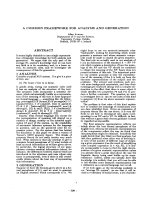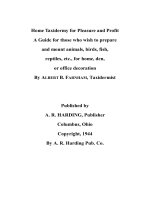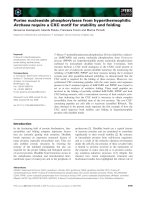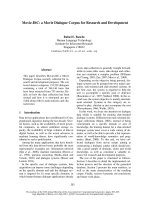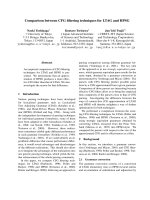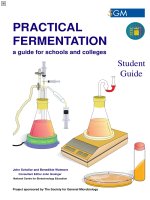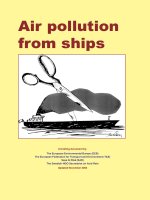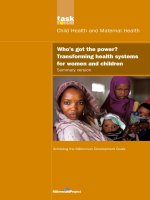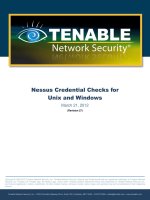Integrative Science for Society and Environment pot
Bạn đang xem bản rút gọn của tài liệu. Xem và tải ngay bản đầy đủ của tài liệu tại đây (706.49 KB, 8 trang )
Integrative Science
for Society and
Environment
A Strategic Research Initiative
Integrative Science for Society and Environment:
A Strategic Research Initiative
Developed by the Research Initiatives Subcommittee of the LTER Planning Process
Conference Committee and the Cyberinfrastructure Core Team
Research Initiatives Subcommittee:
Scott L. Collins, Dept of Biology, University of New Mexico, Committee Chair
Scott M. Swinton, Dept of Agricultural Economics, Michigan State University
Charles W. (Andy) Anderson, Teacher Education, Michigan State University
Ted Gragson, Dept of Anthropology, University of Georgia
Nancy B. Grimm, School of Life Sciences, Arizona State University
Morgan Grove, USDA Forest Service, Burlington, VT
Alan K. Knapp, Dept of Biology, Colorado State University
Gary Kofinas, Resilience and Adaptation Program, University of Alaska
John Magnuson, Center for Limnology, University of Wisconsin
Bill McDowell, Dept of Natural Resources, University of New Hampshire
John Melack, Dept of Ecology, Evolution and Marine Biology; University of California,
Santa Barbara
John Moore, Natural Resources Ecology Lab, Colorado State University
Laura Ogden, Dept of Sociology and Anthropology, Florida International University
O. James Reichman, National Center for Ecological Analysis and Synthesis, University of
California, Santa Barbara
G. Philip Robertson, Kellogg Biological Station, Michigan State University
Melinda D. Smith, Dept of Ecology and Evolutionary Biology, Yale University
Ali Whitmer, Georgetown College Dean’s Office, Georgetown University
Cyberinfrastructure Core Team:
Barbara Benson, North Temperate Lakes LTER, University of Wisconsin
James Brunt, LTER Network Office, University of New Mexico
Don Henshaw, Andrews LTER, USDA Forest Service, Corvallis, OR
John Porter, Virginia Coastal Reserve LTER, University of Virginia
John Vande Castle, LTER Network Office, University of New Mexico
Editor: Peter Taylor, Waterview Consulting
Creative Director: Monica Pessino, Marine Science Institute, UC Santa Barbara
Development of the ISSE was supported
by a grant from the National Science
Foundation (NSF) DEB-0435546.
Download a PDF of the complete LTER Decadal Plan and Integrated Science for Society
and Environment report at www.lternet.edu/decadalplan/
We live in unprecedented times. The global human popula-
tion, which may reach 10 billion by 2050, is making increasing
demands on natural resources, resulting in rapid, extensive, and
pervasive changes in Earth’s systems (Fig.1, 1, 2, 3, 4). Many of
these changes are also presenting unprecedented challenges
to our understanding of how the biosphere works—how the
systems on which we depend will be altered by changes in cli-
mate, land use, biodiversity, and a host of related environmental
attributes. In short, we need to understand how the planet will
operate in the coming decades, and what we can do to sustain
and improve its habitability.
To meet these challenges requires a different approach to U.S.
environmental research, one that is integrated, systems-oriented,
and holistic at multiple scales. Fundamental questions require
interdisciplinary approaches that can
•detectimportantchangesinEarth’ssystems,
•understandchangeinthecontextofintegratedsocialand
ecological systems, and
•providetheinformationneededforsuccessfulsolutions.
A new fundamental research initiative is warranted. Integrative
Science for Society and the Environment (ISSE) is intended to
elevate environmental science in the U.S. to a new level of inte-
gration, collaboration, and synthesis needed to address these
pressing, emerging challenges. The ISSE is based on the belief
that the transformative knowledge needed for this effort can be
delivered best through a programmatic framework that explicitly
identifies the basic socio-ecological linkages that underlie the
biosphere’s response to environmental change.
The issues involved transcend traditional boundaries between
the biophysical and social sciences and cross all ecosystem
types. Thus the ISSE has been created by a diverse group of
biophysical and
social scientists—
ecologists, soci-
ologists, geolo-
gists, economists,
oceanographers,
and geographers,
among others.
This interdisci-
plinary strength is
at the core of the
program.
Ecosystem Services
Goods and services that humans receive from
nature are called ecosystem services. Human
impacts affect the ability of ecosystems to provide
these services. e following are some types of
ecosystem services.
• Provisioning services are products such as
food, fuel, fiber, fresh water, natural biochemi-
cals, and genetic resources.
• Regulating services are benefits that people
obtain from natural regulation of air quality,
climate, erosion, disease, soil, and water quality.
• Cultural services are nonmaterial benefits that
people obtain from the aesthetic, educational,
recreational, and spiritual aspects of ecosystems.
Interdisciplinary
research is a process of
collaboration among
scientists with varied,
complementary exper-
tise to make discover-
ies that would not be
attainable otherwise.
Integrative science
seeks to produce
new understanding
of complex issues by
bringing together and
coordinating diverse
expertise, programs,
and infrastructure.
Synthesis seeks a new,
unified understanding
by combining different
ideas and information.
Figure 1. Long-term trends in the global human popula-
tion, human energy consumption, reactive N produced
by humans, CO
2
concentration of the atmosphere, and
the global temperature anomaly. Note the directional
and cumulative increase in these metrics of global hu-
man impacts over the past 50 years. Population data are
from the US Census Bureau (www.census.gov); energy
consumption from the US Department of Energy Energy
Information Administration (www.eia.doe.gov); total
reactive N from Galloway et al. (2003); atmospheric CO
2
concentrations from the Carbon Dioxide Information
Analysis Center (CDIAC, cdiac.esd.ornl.gov); and global
average temperature anomaly data (Brohan et al. 2006)
from the Met Office Hadley Centre for Climate Change
(hadobs.metoffice.com). Modified from Smith et al.
(2008).
Overview
&
W
Objectives
Today’s environmental issues cannot be
investigated sufficiently with existing dis-
ciplinary approaches or with the limited
interdisciplinary funding opportunities
that are currently available. Scientists have
repeatedly called for more opportunities
for collaborative research between the
ecological, geological, and social sci-
ences (8, 10, 11, 12, 13, 14, 15, 16, 17).
They often identify needs yet rarely put
forward viable mechanisms for promoting
interdisciplinary science. A comprehen-
sive framework is needed to encourage
relevant disciplinary research and enable
integrative research among disciplines.
Through workshops with ecologists, geol-
ogists, and social scientists, we have de-
veloped a proposed framework for ISSE
that explicitly integrates these disciplines
via a series of broad questions (Fig.2).
These questions can be operationalized
locally, regionally, and globally to address
specific issues related to biophysical
systems, ecosystem services, and human
responses and outcomes. They also can
be addressed over time frames from sec-
onds to centuries. Unlike other more linear
approaches (e.g., 14), the ISSE framework
is an interactive network of linkages and
feedbacks among biophysical and social
sciences. The framework will rely on theo-
retical, empirical, and methodological
contributions that connect the disciplines.
This framework also will contribute sub-
stantially to development and testing of
theory within these disciplines
This initiative is motivated by fundamental observations about the environmental im-
pacts of resource consumption and human population growth at international, national,
and local scales. Some environmental impacts are long-term changes, or presses, that
occur over decades or centuries, such as buildup of atmospheric carbon dioxide.
Other impacts are short-term events, or pulses, that happen over brief periods once
or repeatedly, such as wildfires and El Niño. Human-caused global environmental
change is increasing the strength of the long-term impacts and altering the frequency
and intensity of the short-term impacts. Fundamental processes in ecosystems—such as
hundred-year fire cycles and nutrient cycles—are being reshaped by human activities
with largely unknown long-term consequences.
Motivation for this initiativeAN INTEGRATED
RESEARCH
FRAMEWORK
Figure 2. An integrative and iterative conceptual framework for socio-ecological research. Interactions within this
framework are driven by a set of general questions (Q1-Q5, see box 8) that create information pathways for linking
the ecological, geological, and social sciences. This very general framework can be operationalized for a variety of
ecosystem types (see Box 1 for an example), and across spatial scales. Indeed, this framework is designed to ac-
comodate the potentially disparate scales of research across these disciplines.
At global and national scales, the ecological and sociological changes are creating an
environmental crisis. As human population continues to expand (5, 6) with attendant
land-use, technological, and economic changes, additional demands will be placed
on ecosystem services (7). These demands will require integrated, long-term research
that spans multiple disciplines and ultimately can provide solutions for the environment
and society.
At the core of this initiative is the increased understanding that humans are embedded
in Earth’s ecological systems and that studying ecological systems without consider-
ation of the sociological system does little to advance our ability to solve complex
environmental problems. It is widely acknowledged that research must treat humans as
integral to ecosystems and that forward-looking research is essential to help maintain
Earth’s systems while meeting human needs (8). Schematically, we view socio-eco-
logical systems as embedded within and interacting with an increasingly variable and
changing climate system.
Geologists, ecologists, and social scientists examine how systems are organized and
the influences of internal versus external factors (9). Moving environmental science to
a new level of research collaboration, synthesis, and integration requires a shift from
viewing humans as external drivers of natural systems to that of agents acting within
socio-ecological systems (10).
Cyberinfrastructure
Cyberinfrastructure describes research environ-
ments “that support advanced data acquisition,
data storage, data management, data integra-
tion, data mining, data visualization and other
computing and information processing services
over the Internet. In scientific usage, cyberin-
frastructure is a technological solution to the
problem of efficiently connecting data, comput-
ers, and people with the goal of enabling deriva-
tion of novel scientific theories and knowledge”
(20). Cyberinfrastructure also includes people
and organizations that operate and maintain
equipment, develop and support software, create
standards and best practices, and provide other
key services such as security and user support.
General Research Questions
in ISSE Framework
Q1
How do long-term and short-term human
impacts interact to alter ecosystem
structure and function?
Q2
How can biological characteristics of
an ecosystem be both the causes and
consequences of fluxes of energy and matter?
Q3
How do changes in ecosystem dynamics
affect ecosystem services?
Q4
How do changes in ecosystem services feed
back to alter human behavior?
Q5
Which human actions influence the
frequency, magnitude, and form of human
impacts across ecosystems, and what
determines these human actions?
Recommendations
Many recent reports have
identified critical barriers
to creating knowledge that
can provide the generality
and predictive capabilities
needed for solutions to
environmental and societal
problems. In ISSE we recom-
mend more opportunities
for long-term research by
individual investigators and
teams, more resources for in-
terdisciplinary research, more
opportunities for synthesis
of existing research, and the
creation of a network-scale,
interdisciplinary, long-term
research program.
The ISSE will increase society’s awareness of environmental
problems and its ability to develop solutions by (1)
expanding understanding at many scales of geography and
time, (2) developing cyberinfrastructure for integration and
collaboration, and (3) building intellectual capacity for
integration and public engagement.
I. Expand understanding at many scales of geography
and time. To fulfill the ISSE research goals, we recommend the
following actions:
Action 1: Enhance and expand collaborative research
opportunities.
Action 2: Expand opportunities for interdisciplinary
collaboration.
Action 3: Expand opportunities for long-term research.
Action 4: Expand opportunities for synthesis.
Action 5: Create a long-term, multi-site, socio-ecological
research program.
Human activities are an integral part of ecosystems, and envi-
ronmental research must become more forward-looking and
focused on maintaining Earth’s systems and meeting human
needs (3, 4, 8). Challenges include organizing interdisciplin-
ary partnerships, coordinating research networks, and making
information more readily available. A long-term approach is
essential to understand complex socio-ecological systems
where events are interdependent, play out in the long term,
and respond strongly to both long-term and short-term im-
pacts. Crucial scientific questions can be answered only with
long-term data, yet programs supporting such investigations
are few and those that
do exist are insufficiently
funded. It is imperative
that social science be an
integral part of these long-
term research and educa-
tion initiatives (18, 19).
Understanding the
complex interactions in
socio-ecological systems
requires new levels of
information synthesis as
huge quantities of data—
often highly detailed from
diverse sources-—be-
come available and as the
issues we face become
more urgent and interde-
pendent. The importance
of both retrospective and
predictive synthesis has
never been greater.
Many issues facing society today are complex and occur over long time periods and
broad spatial scales. Yet no mechanisms currently exist for network-scale, long-term,
multi-site, interdisciplinary research programs built on a socio-ecological framework.
Network-scale interdisciplinary research would address fundamental theoretical issues
in socio-ecological research and lay the groundwork for the syntheses of the future.
II. Develop cyberinfrastructure for integration and collaboration. To fulfill the ISSE
cyberinfrastructure goals, we recommend the following actions:
Action 6: Support the deployment, integration, and interoperability of cyberinfra-
structure, standards, and people across environmental networks.
Action 7: Support curated repositories for data and models to expand the knowl-
edge base for synthetic research.
Action 8: Invest in programs for technology transfer and training of information
specialists and scientists.
Action 9: Support technology developments in socio-ecological informatics.
Action 10: Enhance data collection and information management systems relevant
to socio-ecological research.
Investments in cyberinfrastructure and workforce development are necessary to meet
the challenges of the ISSE initiatives for integrative research and education at multiple
scales; across disciplines; and using resources, data, and expertise at geographically
distributed sites. These investments will create new capacity for collaboration, scien-
tific integration, and information transfer.
Interdisciplinary research initiatives require more coherent, interoperable systems to
locate, access, and integrate information from multiple disciplines as well as provide
findings in forms useful to educators and the public. Major technological barriers exist
for researchers, data service providers, and educators. Resolving these issues will in-
volve expanded resources of people, technology, and capacity at dispersed sites and
at centralized facilities.
Significant new investment in information technology must include programs for tech-
nology transfer and training of information specialists, scientists, and educators. Creat-
ing virtual organizations of science teams and working groups through implementation
of collaboration technology will be a crucial component of the information technology-
enabled knowledge environment for ISSE science.
Existing online data and documentation are valuable resources for integrative, synthetic
research, but new data volumes and data types create challenges for data throughput
and quality. In many cases, data mediation solutions are still areas of active research in
information technology. Socio-ecological research projects of the ISSE represent a valu-
able opportunity to test and implement these evolving technologies.
ISSE demands the development of new integrative models, advanced analytical and
visualization tools, and scientific workflow environments. The research initiatives will
require reliable, usable, and extensible information systems to achieve their objectives.
III. Building intellectual capacity for integration and public engagement. To fulfill
the ISSE goals for building intellectual capacity, we recommend the following actions:
Action 11: Support environmental education research focusing on learning
progressions, curriculum development, and pedagogy that facilitates
science literacy.
Action 12: Support network-level efforts to engage broad participation represent-
ing our diverse society.
Action 13: Engage K-16 students in inquiry-based science education that integrates
socio-ecological disciplines and focuses on working with data.
Action 14: Provide opportunities for graduate students to conduct interdisciplinary
research within the context of large temporal and spatial scales.
Box 1. Social and Ecological Cycles
in Lake Management
Human activities and lake ecosystems of Madi-
son, Wisconsin, have undergone several cycles of
change since European settlement in 1840 (30).
In each cycle, human activities affected hydrol-
ogy, water chemistry, or the food web, leading to
changes in lake water levels, water quality, fisher-
ies, or recreational uses. e shifts in ecosystem
services spurred social responses, such as forma-
tion of new institutions for lake management and
changes in mandates of existing institutions. e
intent has been to modify human activity and
the ecosystem to improve ecosystem services. But
in each cycle, new problems caught managers by
surprise, just as they were beginning to solve the
old problems.
In the late 1940s, for example, water quality
deteriorated sharply because of increased pollu-
tion from sewage and agricultural fertilizer. In
1971, sewage was diverted, but the lakes failed to
recover as people had hoped. irty years of in-
tensive use of fertilizer had transformed soils into
a persistent source of non-point pollution. In the
1980s, an initial attempt to mitigate non-point
pollution failed because of inadequate attention
to farmer behavior and farm microeconomics.
From 1987 to 1994, managers restored game fish
to the lake food web, leading to reductions in nui-
sance algae and better water quality. Despite these
improvements, toxic algae blooms episodically
choked the lakes. In 1997, a new initiative sought
to address the problem of non-point pollution
with a wider diversity of policy instruments. By
then, however, land development had increased
the impervious surface in the watersheds, causing
greater variation in lake levels and flushing rates.
Point- and non-point pollution with phosphorus in lakes
of the North Temperate Lakes LTER can cause blooms of
toxic and noxious cyanobacteria. For more information,
see
The nature and scope of environmental science as envisioned in ISSE requires a new
approach to recruiting and training future scientists at the undergraduate and graduate
levels. The composition of the research community must reflect the diverse public that
we serve and from whom we seek support (21, 22). And we must engage students in sci-
entific inquiry that includes an interdisciplinary approach to understanding global issues.
We recognize these two goals—engaging a more representative student body and
improving science education, particularly in the realm of socio-ecological sciences—
as separate but interconnected. We can accomplish these goals through innovative cur-
riculum and research experiences that are designed to expand recruitment and reten-
tion of a diverse student body. Studies have demonstrated that an innovative, authentic
curriculum improves recruitment and retention of students from diverse ethnic and
gender groups (23, 24, 25, 26, 27, 28, 29).
We propose an integrative approach to student diversity and curriculum. This ap-
proach would include implementing near-peer mentoring, promoting collaboration
in undergraduate research, integrating curricula across biophysical and social science
disciplines, and broadening our definition of ecological science career pathways. At
the graduate level, increasing numbers of students must be engaged in interdisciplinary
research that includes broad spatial and temporal perspectives.
To move us wisely into the future, all citizens need environmental science literacy to
understand the challenges and opportunities presented by environmental issues. Edu-
cators and scientists can provide students with opportunities to develop two critical
abilities that, in combination, define environmental science literacy: understanding and
evaluating arguments from evidence and using scientific knowledge effectively in argu-
ments and decisions about human freedom, opportunity, and justice.
The ISSE framework includes research and outreach activities to foster environmental
science literacy. Initiatives at the national level will focus on identifying relevant socio-
ecological content in K-12 education,
understanding how students learn this
content, and promoting implementation
of teaching practice and standards to
facilitate environmental science literacy.
Local and regional efforts will engage
teachers and students directly and will
foster relationships among scientists,
undergraduate and graduate students,
and the K-12 community. The scope and
urgency of environmental issues obliges
us to prepare future scientists and a
public that understands the complex-
ity, nature, and limitations of our shared
resources.
International Perspectives
A theme that will run throughout the ISSE
initiative—from research to cyberinfrastructure
to education—is the need to incorporate interna-
tional awareness and participation. Working with
colleagues around the world—learning from their
models, data, and expertise—is invaluable for
researchers. And to truly understand the role of
humans in the environment, we need to under-
stand the role of all humans and their cultures.
Rapid, extensive changes in Earth’s systems, the conditions responsible for the changes,
and the societal responses to them demand a new, interdisciplinary science. The
proposed Integrated Science for Society and Environment initiative will significantly
increase the capacity of the research community to detect, understand, and respond to
the known and anticipated changes in our socio-ecological systems, and to transfer that
information to key user groups. These anticipated changes include the following:
•Globalclimatechange,variability,andrelatedrisk.
•Alteredhydrologiccycles.
•Alteredbiogeochemicalcycles.
•Alteredbioticstructure.
•Dynamicsoflanduse,landmanagement,andlandcover.
•Alteredecosystemfunctionandecosystemservices.
•Changesinhumanhealth,well-being,andsecurity.
The Integrated Science for Society and Environment initiative can move us to a new level
of science and education that is recognized as essential in these unprecedented times.
ISSE will increase the capacity of educators and society to respond to these challenges.
ISSE will encompass the diversity of socio-ecological science; generate the scientific
and cyberinfrastructure tools needed to understand complex socio-ecological systems;
and establish the educational programs that are necessary for the next generation.
THE CHALLENGE THE POTENTIAL
&
Niwot Ridge LTER students learn how to identify flowers.
Sevilleta researchers demonstrate hantavirus handling
techniques at the groundbreaking ceremonies for Sevil-
leta Education and Research Facility, July 6, 2005.
Swimming pools are a common feature of the hot,
desert city of Phoenix, AZ. The urban heat island has
worsened summer heat. For more information, see
The mangrove forest at Florida Coastal Everglades LTER
Program (SRS-6 site about 2 km from the Gulf of Mexi-
co) before (top) and after Hurricane Wilma’s landfall in
October 2005 (see http://fcelter.fiu.edu for details).
BioCON (Biodiversity, CO2, and Nitrogen) is an ecologi-
cal experiment designed to study the ways in which
plant communities will respond to 3 environmental
changes that are known to be occurring on a global
scale: increasing nitrogen deposition, increasing atmo-
spheric CO2, and decreasing biodiversity.
(1) Steffen, W., Sanderson, A., Jäger, J., Tyson, P.D., Moore
III, B., Matson, P.A., Richardson, K., Oldfield, F., Schellnhuber,
H J., Turner II, B.L., Wasson, R.J. 2004. Global change and the
Earth system: a planet under pressure. Springer-Verlag, N.Y.
(2) Millennium Ecosystem Assessment. 2005. Ecosystems
and human well-being: current state and trends. Island
Press, Washington, DC.
(3) Millennium Ecosystem Assessment. 2005. Ecosystems and
human well-being: scenarios. Island Press, Washington, DC.
(4) Millennium Ecosystem Assessment. 2005. Ecosystems and
human well-being: synthesis. Island Press, Washington, DC.
(5) Lutz, W., W. Sanderson and S. Scherbov. 2001. The end
of world population growth. Nature 412: 543-545.
(6) Cohen, J.J. 2003. Human population: The next half
century. Science 302:1172-1175.
(7) Daily, G.C., T. Soderqvist, S. Aniyar, K. Arrow, P. Dasgupta,
P.R. Ehrlich, C. Folke, A. Jansson, B-O. Jansson, N. Kautsky,
S. Levin, J. Lubchenco, K-G. Maler, D. Simpson, D. Starrett,
D. Tilman and B. Walker. 2000. The value of nature and the
nature of value. Science 289:395-396.
(8) Palmer, M.A., E. Bernhardt, E. Chornesky, S.L. Collins,
A. Dobson, C. Duke, B. Gold, R. Jacobson, S. Kingsland, R.
Kranz, M. Mappin, F. Micheli, J. Morse, M. Pace, M. Pascual,
S. Palumbi, J. Reichman, W.H. Schlesinger, A. Townsend,
M. Turner, and M. Vasquez. 2004. Ecology for a crowded
planet. Science 304:1251-1252.
(9) Pickett, S.T.A., M.L. Cadenasso, J.M. Grove, C.H. Nilon,
R.V. Pouyat, W.C. Zipperer, and R. Constanza. 2001. Urban
ecological systems: linking terrestrial ecological, physical
and socioeconomic components of metropolitan areas. An-
nual Review of Ecology and Systematics 32:127-157.
(10) Grimm, N.B., J.M. Grove, S.T.A. Pickett and C.L. Redman.
2000. Integrated approaches to long-term studies of urban
ecological systems. BioScience 50:571-584.
(11) Robertson, G. P., J. C. Broome, E. A. Chornesky, J. R.
Frankenberger, P. Johnson, M. Lipson, J. A. Miranowski, E. D.
Owens, D. Pimentel, and L. A. Thrupp. 2004. Rethinking the
vision for environmental research in U.S. agriculture. Biosci-
ence 54:61-65.
(12) Newell, P. 2005. Race, class and the global politics of en-
vironmental inequality. Global Environmental Politics 5:70-94.
(13) Palmer, M.A., E. Bernhardt, E. Chornesky, S.L. Collins, A.
Dobson, C. Duke, B. Gold, R. Jacobson, S. Kingsland, R. Kranz,
M. Mappin, F. Micheli, J. Morse, M. Pace, M. Pascual, S. Palum-
bi, J. Reichman, W.H. Schlesinger, A. Townsend, M. Turner,
and M. Vasquez. 2005. Ecology for the 21st century: an action
plan. Frontiers in Ecology and the Environment 3:4-11.
(14) Kremen, C. and R.S. Ostfeld. 2005. A call to ecologists:
measuring, analyzing and managing ecosystem services.
Frontiers in Ecology and the Environment 3:540-548.
(15) Balmford, A. and W. Bond. 2005. Trends in the state of
nature and their implications for human well-being. Ecology
Letters 8:1218-1234.
(16) Farber, S., R. Costanza, D. L. Childers, J. Erickson, K. L.
Gross, M. Grove, C. S. Hopkinson, J. Kahn, S. Pincetl, A. Troy,
P. Warren, and M. A. Wilson. 2006. Linking ecology and eco-
nomics for ecosystem management. BioScience 56:121-133.
(17) Haberl, H., V. Winiwarter, K. Andersson, R. U. Ayres,
C. Boone, A. Castillo, G. Cunfer, M. Fischer-Kowalski, W.
R. Freudenburg, E. Furman, R. Kaufmann, F. Krausmann, E.
Langthaler, H. Lotze-Campen, M. Mirtl, C. L. Redman, A.
Reenberg, A. Wardell, B. Warr, and H. Zechmeister 2006.
From LTER to LTSER: conceptualizing the socioeconomic
dimension of long-term socioecological research. Ecology
and Society 11: URL: />vol11/iss2/art13/ (viewed February 2007).
(18) Briggs, J.M., K.A. Spielman, H. Schaafsma, K.W. Kintigh,
M. Kruse, K. Morehouse and K. Schollmeyer. 2006. Why ecol-
ogy needs archaeologists and archaeology needs ecologists.
Frontiers in Ecology and the Environment 4:180-188.
(19) Magnuson, J.J., T.K. Kratz, and B.J. Benson 2006. Long-
term dynamics of lakes in the landscape: long-term ecologi-
cal research on north temperate lakes. Oxford University
Press, London, UK.
(20) Atkins, D., K. Kroegemeier, S. Feldman, H. Garcia-Moli-
na, M. Klein, D.G. Messerschmitt, P. Messina, J.P. Ostriker and
M.H. Wright. 2003. Revolutionizing science and engineering
through cyberinfrastructure: report of the National Science
Foundation Blue-Ribbon Advisory Panel on Cyberinfrasturcu-
ture. Arlington, VA: National Science Foundation.
(21) Committee on Science, Engineering and Public Policy
(COSEPUP). 2005. Rising above the gathering storm: energiz-
ing and employing America for a brighter economic future.
National Academies Press. Washington, DC.
(22) Ortega, S., A. Flecker, K. Hoffman, L. Jablonski,
J. Johnson-White, M. Jurgenson-Armstrong, R. Kimmerer, M.
Poston, A. Socha, and J. Taylor. 2006. Women and minorities
in ecology II (WAMIE II) report. Ecological Society of America.
(23) Kardash,C.M. 2000. Evaluation of an undergraduate
research experience: perceptions of undergraduate interns
and their faculty mentors. Journal of Educational Psychology
92:191-201.
(24) Bauer, K.W., and J.S. Bennett. 2003. Alumni perceptions
used to assess undergraduate research experience. Journal
of Higher Education 74:210-230.
(25) Rahm, J., M-P Reny, and J.C. Moore. 2005. The role of
after-school and summer science programs in the lives of
urban youth. School Science and Mathematics 105:1-9.
(26) Rahm, J., H.C. Miller, L. Hartley and J.C. Moore. 2003.
The value of an emergent notion of authenticity: examples
from two student/teacher-scientist partnership programs.
Journal of Research in Science Teaching 40:737-756.
(27) Lopatto, D. 2004. What undergraduate research can tell
us on research on learning. Project Kaleidoscope 4:1-8.
(28) Seymour, E., A. B. Hunter, S. L. Laursen and T. DeAntoni.
2004. Establishing the benefits of research experiences for
undergraduates in the sciences: first findings from a three-
year study. Science Education 88:493-534.
(29) Russell, A. 2005. Strengthening the science and math-
ematics pipeline for a better America. American Association
of State Colleges and Universities 2: Nov./Dec. 2005.
(30) Carpenter, S.R., R.C. Lathrop, P. Nowak, E.M. Bennett,
T. Reed and P.A. Saranno. 2005. The ongoing experiment:
restoration of Lake Mendota and its watershed. Pp. 236-256
in J.J. Magnuson, T.K. Kratz and B.J. Benson, eds. Long-term
dynamics of lakes in the landscape. Oxford Univ. Press,
London, UK.
Literature Cited
